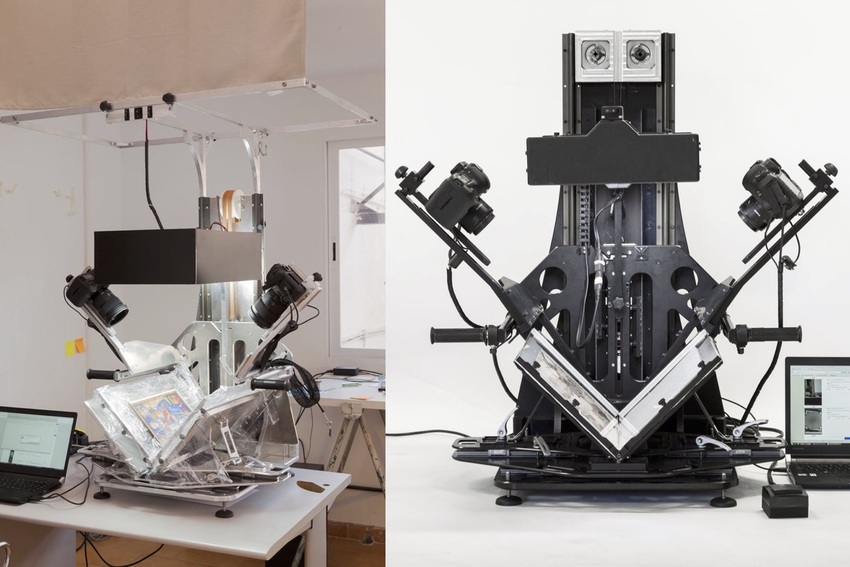The scanner is capable of recording 100 pages per hour at 800 dpi and 1:1 up to approx. A3 size (40 x 25cm). The hardware has been designed to cope with recording thick books with spines up to 8cm wide.
During a recording, the book is placed on a v-shaped cradle and opened to 90 degrees on the first page. The operator manually brings the methacrylate plate into contact with the paper to gently flatten the pages without risking the integrity of the paper or applying pressure to the binding. The two Canon 5DSR cameras are activated through the custom-made ManuCapture software using the foot-pedal shutter and the images are automatically downloaded onto the computer and stored with metadata tags. When the image has been downloaded, the operator lifts the methacrylate plate in order to turn the page and continue the recording. The operator must always use both hands and feet for efficient operation of the scanner, increasing speed whilst reducing risk to the book.
Factum Foundation’s manuscript scanner, unlike many commercial options, uses standard photographic equipment to produce images of extraordinary sharpness and quality, demonstrating that the often prohibitively expensive photographic equipment used in many archive digitisation efforts may not be essential to producing good results.

Features of the photographic manuscript scanner.
Adaptable book-tray
Allows the user to adjust the spine width and opening angle i.e. adaptable to books of different sizes and in varying states of conservation. The maximum spine width is 8 cm and the angle can be adjusted between 80º and 100º. The book tray is lined to protect the binding of the manuscript.
Photographic system
The scanner is fitted with two Canon 5DSR with Sigma Art 50mm lenses. The two cameras are released at the same time by pushing the shutter foot-pedal. Two methacrylate plates keep the pages of the book flat and at a fixed distance from the lenses. The images are quickly downloaded onto the computer by means of USB 3.0 cables.
Shield and vertical guides
A mobile system is used to lift and lower the photographic system so that the operator can turn the pages of the book. The system is counterweighted with springs and comprises a blocking system to control positioning with as little effort as possible. The shield is articulated in order that the methacrylate plate can be adjusted to the angle of the book (80º, 90º and 100º).
Computer with custom software application
The custom software application ManuCapture software has been written by a team of in-house engineers for Factum Foundation. The software controls the two cameras on the scanner. It allows the operator to calibrate the system in order to ensure correct exposures and allow colour management operations in image post-processing. During image capture, ManuCapture automatically composes page sequences and adds metadata tags to each image.
For more information on the Photographic Manuscript Scanner contact info@factumfoundation.org.
The portable manuscript scanner was designed by a team from Factum Foundation. The team was led by Enrique Esteban, with support from Jorge Cano, Quinner Baird, Isabel Fernández López, and Gabriel Scarpa.













